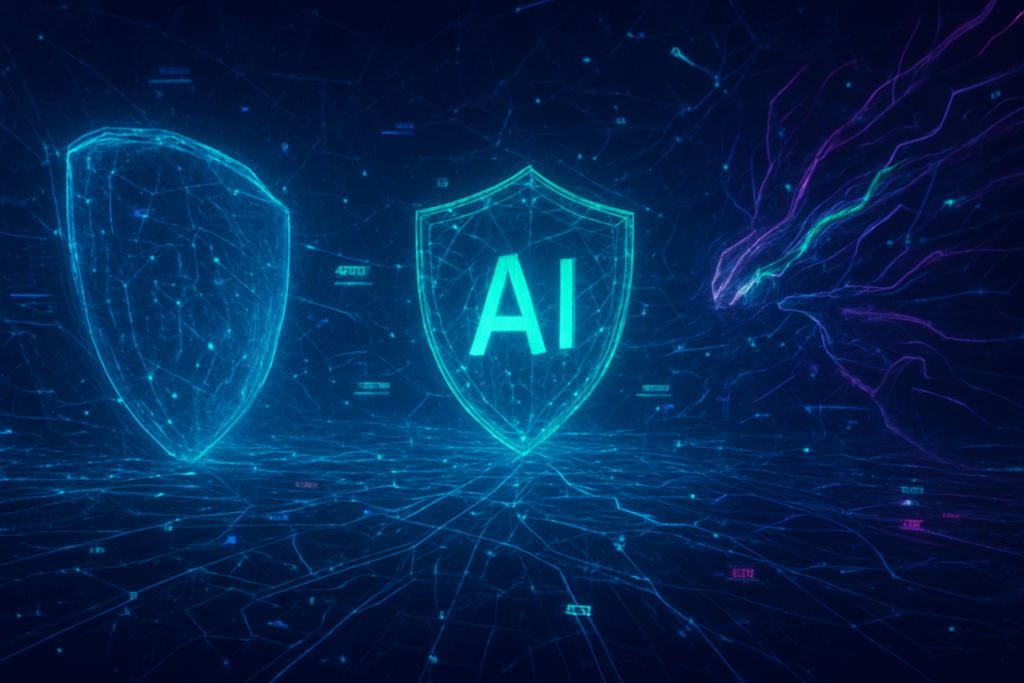
As the digital landscape rapidly evolves, the year 2026 is poised to mark a pivotal moment in cybersecurity, fundamentally reshaping how organizations defend against an ever-more sophisticated array of threats. At the heart of this transformation lies Artificial Intelligence (AI), which is no longer merely a supportive tool but the central battleground in an escalating cyber arms race. Both benevolent defenders and malicious actors are increasingly leveraging AI to enhance the speed, scale, and precision of their operations, moving the industry from a reactive stance to one dominated by predictive and proactive defense. This shift promises unprecedented levels of automation and insight but also introduces novel vulnerabilities and ethical dilemmas, demanding a complete re-evaluation of current security strategies.
The immediate significance of these trends is profound. The cybersecurity market is bracing for an era where AI-driven attacks, including hyper-realistic social engineering and adaptive malware, become commonplace. Consequently, the integration of advanced AI into defensive mechanisms is no longer an option but an urgent necessity for survival. This will redefine the roles of security professionals, accelerate the demand for AI-skilled talent, and elevate cybersecurity from a mere IT concern to a critical macroeconomic imperative, directly impacting business continuity and national security.
AI at the Forefront: Technical Innovations Redefining Cyber Defense
By 2026, AI's technical advancements in cybersecurity will move far beyond traditional signature-based detection, embracing sophisticated machine learning models, behavioral analytics, and autonomous AI agents. In threat detection, AI systems will employ predictive threat intelligence, leveraging billions of threat signals to forecast potential attacks months in advance. These systems will offer real-time anomaly and behavioral detection, using deep learning to understand the "normal" behavior of every user and device, instantly flagging even subtle deviations indicative of zero-day exploits. Advanced Natural Language Processing (NLP) will become crucial for combating AI-generated phishing and deepfake attacks, analyzing tone and intent to identify manipulation across communications. Unlike previous approaches, which were often static and reactive, these AI-driven systems offer continuous learning and adaptation, responding in milliseconds to reduce the critical "dwell time" of attackers.
In threat prevention, AI will enable a more proactive stance by focusing on anticipating vulnerabilities. Predictive threat modeling will analyze historical and real-time data to forecast potential attacks, allowing organizations to fortify defenses before exploitation. AI-driven Cloud Security Posture Management (CSPM) solutions will automatically monitor APIs, detect misconfigurations, and prevent data exfiltration across multi-cloud environments, protecting the "infinite perimeter" of modern infrastructure. Identity management will be bolstered by hardware-based certificates and decentralized Public Key Infrastructure (PKI) combined with AI, making identity hijacking significantly harder. This marks a departure from reliance on traditional perimeter defenses, allowing for adaptive security that constantly evaluates and adjusts to new threats.
For threat response, the shift towards automation will be revolutionary. Autonomous incident response systems will contain, isolate, and neutralize threats within seconds, reducing human dependency. The emergence of "Agentic SOCs" (Security Operations Centers) will see AI agents automate data correlation, summarize alerts, and generate threat intelligence, freeing human analysts for strategic validation and complex investigations. AI will also develop and continuously evolve response playbooks based on real-time learning from ongoing incidents. This significantly accelerates response times from days or hours to minutes or seconds, dramatically limiting potential damage, a stark contrast to manual SOC operations and scripted responses of the past.
Initial reactions from the AI research community and industry experts are a mix of enthusiasm and apprehension. There's widespread acknowledgment of AI's potential to process vast data, identify subtle patterns, and automate responses faster than humans. However, a major concern is the "mainstream weaponization of Agentic AI" by adversaries, leading to sophisticated prompt injection attacks, hyper-realistic social engineering, and AI-enabled malware. Experts from Google Cloud (NASDAQ: GOOGL) and ISACA warn of a critical lack of preparedness among organizations to manage these generative AI risks, emphasizing that traditional security architectures cannot simply be retrofitted. The consensus is that while AI will augment human capabilities, fostering "Human + AI Collaboration" is key, with a strong emphasis on ethical AI, governance, and transparency.
Reshaping the Corporate Landscape: AI's Impact on Tech Giants and Startups
The accelerating integration of AI into cybersecurity by 2026 will profoundly reshape the competitive landscape for AI companies, tech giants, and startups alike. Companies specializing in AI and cybersecurity solutions are poised for significant growth, with the global AI in cybersecurity market projected to reach $93 billion by 2030. Firms offering AI Security Platforms (AISPs) will become critical, as these comprehensive platforms are essential for defending against AI-native security risks that traditional tools cannot address. This creates a fertile ground for both established players and agile newcomers.
Tech giants like Microsoft (NASDAQ: MSFT), Google (NASDAQ: GOOGL), Nvidia (NASDAQ: NVDA), IBM (NYSE: IBM), and Amazon Web Services (AWS) (NASDAQ: AMZN) are aggressively integrating AI into their security offerings, enhancing their existing product suites. Microsoft leverages AI extensively for cloud-integrated security and automated workflows, while Google's "Cybersecurity Forecast 2026" underscores AI's centrality in predictive threat intelligence and the development of "Agentic SOCs." Nvidia provides foundational full-stack AI solutions for improved threat identification, and IBM offers AI-based enterprise applications through its watsonx platform. AWS is doubling down on generative AI investments, providing the infrastructure for AI-driven security capabilities. These giants benefit from their vast resources, existing customer bases, and ability to offer end-to-end security solutions integrated across their ecosystems.
Meanwhile, AI security startups are attracting substantial investment, focusing on specialized domains such as AI model evaluation, agentic systems, and on-device AI. These nimble players can rapidly innovate and develop niche solutions for emerging AI-driven threats like deepfake detection or prompt injection defense, carving out unique market positions. The competitive landscape will see intense rivalry between these specialized offerings and the more comprehensive platforms from tech giants. A significant disruption to existing products will be the increasing obsolescence of traditional, reactive security systems that rely on static rules and signature-based detection, forcing a pivot towards AI-aware security frameworks.
Market positioning will be redefined by leadership in proactive security and "cyber resilience." Companies that can effectively pivot from reactive to predictive security using AI will gain a significant strategic advantage. Expertise in AI governance, ethics, and full-stack AI security offerings will become key differentiators. Furthermore, the ability to foster effective human-AI collaboration, where AI augments human capabilities rather than replacing them, will be crucial for building stronger security teams and more robust defenses. The talent war for AI-skilled cybersecurity professionals will intensify, making recruitment and training programs a critical competitive factor.
The Broader Canvas: AI's Wider Significance in the Cyber Epoch
The ascendance of AI in cybersecurity by 2026 is not an isolated phenomenon but an integral thread woven into the broader tapestry of AI's global evolution. It leverages and contributes to major AI trends, most notably the rise of "agentic AI"—autonomous systems capable of independent goal-setting, decision-making, and multi-step task execution. Both adversaries and defenders will deploy these agents, transforming operations from reconnaissance and lateral movement to real-time monitoring and containment. This widespread adoption of AI agents necessitates a paradigm shift in security methodologies, including an evolution of Identity and Access Management (IAM) to treat AI agents as distinct digital actors with managed identities.
Generative AI, initially known for text and image creation, will expand its application to complex, industry-specific uses, including generating synthetic data for training security models and simulating sophisticated cyberattacks to expose vulnerabilities proactively. The maturation of MLOps (Machine Learning Operations) and AI governance frameworks will become paramount as AI embeds deeply into critical operations, ensuring streamlined development, deployment, and ethical oversight. The proliferation of Edge AI will extend security capabilities to devices like smartphones and IoT sensors, enabling faster, localized processing and response times. Globally, AI-driven geopolitical competition will further reshape trade relationships and supply chains, with advanced AI capabilities becoming a determinant of national and economic security.
The overall impacts are profound. AI promises exponentially faster threat detection and response, capable of processing massive data volumes in milliseconds, drastically reducing attack windows. It will significantly increase the efficiency of security teams by automating time-consuming tasks, freeing human professionals for strategic management and complex investigations. Organizations that integrate AI into their cybersecurity strategies will achieve greater digital resilience, enhancing their ability to anticipate, withstand, and rapidly recover from attacks. With cybercrime projected to cost the world over $15 trillion annually by 2030, investing in AI-powered defense tools has become a macroeconomic imperative, directly impacting business continuity and national stability.
However, these advancements come with significant concerns. The "AI-powered attacks" from adversaries are a primary worry, including hyper-realistic AI phishing and social engineering, adaptive AI-driven malware, and prompt injection vulnerabilities that manipulate AI systems. The emergence of autonomous agentic AI attacks could orchestrate multi-stage campaigns at machine speed, surpassing traditional cybersecurity models. Ethical concerns around algorithmic bias in AI security systems, accountability for autonomous decisions, and the balance between vigilant monitoring and intrusive surveillance will intensify. The issue of "Shadow AI"—unauthorized AI deployments by employees—creates invisible data pipelines and compliance risks. Furthermore, the long-term threat of quantum computing poses a cryptographic ticking clock, with concerns about "harvest now, decrypt later" attacks, underscoring the urgency for quantum-resistant solutions.
Comparing this to previous AI milestones, 2026 represents a critical inflection point. Early cybersecurity relied on manual processes and basic rule-based systems. The first wave of AI adoption introduced machine learning for anomaly detection and behavioral analysis. Recent developments saw deep learning and LLMs enhancing threat detection and cloud security. Now, we are moving beyond pattern recognition to predictive analytics, autonomous response, and adaptive learning. AI is no longer merely supporting cybersecurity; it is leading it, defining the speed, scale, and complexity of cyber operations. This marks a paradigm shift where AI is not just a tool but the central battlefield, demanding a continuous evolution of defensive strategies.
The Horizon Beyond 2026: Future Trajectories and Uncharted Territories
Looking beyond 2026, the trajectory of AI in cybersecurity points towards increasingly autonomous and integrated security paradigms. In the near-term (2026-2028), the weaponization of agentic AI by malicious actors will become more sophisticated, enabling automated reconnaissance and hyper-realistic social engineering at machine speed. Defenders will counter with even smarter threat detection and automated response systems that continuously learn and adapt, executing complex playbooks within sub-minute response times. The attack surface will dramatically expand due to the proliferation of AI technologies, necessitating robust AI governance and regulatory frameworks that shift from patchwork to practical enforcement.
Longer-term, experts predict a move towards fully autonomous security systems where AI independently defends against threats with minimal human intervention, allowing human experts to transition to strategic management. Quantum-resistant cryptography, potentially aided by AI, will become essential to combat future encryption-breaking techniques. Collaborative AI models for threat intelligence will enable organizations to securely share anonymized data, fostering a stronger collective defense. However, this could also lead to a "digital divide" between organizations capable of keeping pace with AI-enabled threats and those that lag, exacerbating vulnerabilities. Identity-first security models, focusing on the governance of non-human AI identities and continuous, context-aware authentication, will become the norm as traditional perimeters dissolve.
Potential applications and use cases on the horizon are vast. AI will continue to enhance real-time monitoring for zero-day attacks and insider threats, improve malware analysis and phishing detection using advanced LLMs, and automate vulnerability management. Advanced Identity and Access Management (IAM) will leverage AI to analyze user behavior and manage access controls for both human and AI agents. Predictive threat intelligence will become more sophisticated, forecasting attack patterns and uncovering emerging threats from vast, unstructured data sources. AI will also be embedded in Next-Generation Firewalls (NGFWs) and Network Detection and Response (NDR) solutions, as well as securing cloud platforms and IoT/OT environments through edge AI and automated patch management.
However, significant challenges must be addressed. The ongoing "adversarial AI" arms race demands continuous evolution of defensive AI to counter increasingly evasive and scalable attacks. The resource intensiveness of implementing and maintaining advanced AI solutions, including infrastructure and specialized expertise, will be a hurdle for many organizations. Ethical and regulatory dilemmas surrounding algorithmic bias, transparency, accountability, and data privacy will intensify, requiring robust AI governance frameworks. The "AI fragmentation" from uncoordinated agentic AI deployments could create a proliferation of attack vectors and "identity debt" from managing non-human AI identities. The chronic shortage of AI and ML cybersecurity professionals will also worsen, necessitating aggressive talent development.
Experts universally agree that AI is a dual-edged sword, amplifying both offensive and defensive capabilities. The future will be characterized by a shift towards autonomous defense, where AI handles routine tasks and initial responses, freeing human experts for strategic threat hunting. Agentic AI systems are expected to dominate as mainstream attack vectors, driving a continuous erosion of traditional perimeters and making identity the new control plane. The sophistication of cybercrime will continue to rise, with ransomware and data theft leveraging AI to enhance their methods. New attack vectors from multi-agent systems and "agent swarms" will emerge, requiring novel security approaches. Ultimately, the focus will intensify on AI security and compliance, leading to industry-specific AI assurance frameworks and the integration of AI risk into core security programs.
The AI Cyber Frontier: A Comprehensive Wrap-Up
As we look towards 2026, the cybersecurity landscape is undergoing a profound metamorphosis, with Artificial Intelligence at its epicenter. The key takeaway is clear: AI is no longer just a tool but the fundamental driver of both cyber warfare and cyber defense. Organizations face an urgent imperative to integrate advanced AI into their security strategies, moving from reactive postures to predictive, proactive, and increasingly autonomous defense mechanisms. This shift promises unprecedented speed in threat detection, automated response capabilities, and a significant boost in efficiency for overstretched security teams.
This development marks a pivotal moment in AI history, comparable to the advent of signature-based antivirus or the rise of network firewalls. However, its significance is arguably greater, as AI introduces an adaptive and learning dimension to security that can evolve at machine speed. The challenges are equally significant, with adversaries leveraging AI to craft more sophisticated, evasive, and scalable attacks. Ethical considerations, regulatory gaps, the talent shortage, and the inherent risks of autonomous systems demand careful navigation. The future will hinge on effective human-AI collaboration, where AI augments human expertise, allowing security professionals to focus on strategic oversight and complex problem-solving.
In the coming weeks and months, watch for increased investment in AI Security Platforms (AISPs) and AI-driven Security Orchestration, Automation, and Response (SOAR) solutions. Expect more announcements from tech giants detailing their AI security roadmaps and a surge in specialized startups addressing niche AI-driven threats. The regulatory landscape will also begin to solidify, with new frameworks emerging to govern AI's ethical and secure deployment. Organizations that proactively embrace AI, invest in skilled talent, and prioritize robust AI governance will be best positioned to navigate this new cyber frontier, transforming a potential vulnerability into a powerful strategic advantage.
This content is intended for informational purposes only and represents analysis of current AI developments.
TokenRing AI delivers enterprise-grade solutions for multi-agent AI workflow orchestration, AI-powered development tools, and seamless remote collaboration platforms.
For more information, visit https://www.tokenring.ai/.





